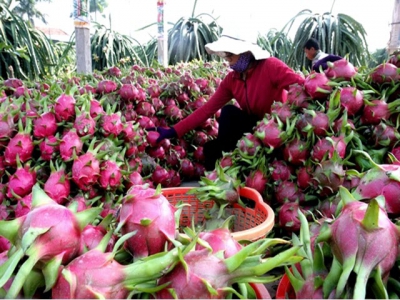North needs more linkages with southern agricultural goods

Ho Chi Minh City — Consumers in the north are fond of many products from the southern region, but have had difficulty accessing them, particularly at supermarkets, because of a lack of supply in the northern market.
Small-scale production and poor logistics services are preventing smooth movement of agricultural goods from the southern to northern regions. — VNS Photo Văn Châu
The supply in Hà Nội, for example, meets only 35 per cent of consumer demand for fruit, 35 per cent for rice, 15 per cent for beef, 5 per cent for aquatic products and 20 per cent for processed food. As such, the region depends on the south for much of its agricultural produce.
Although Hà Nội has more than 10,000ha of vegetable growing area, it meets only 66 per cent of demand, according to the Hà Nội Centre for Agricultural Trade Promotion under the Ministry of Agriculture and Rural Development.
Beside rice and aquatic products, Hà Nội consumes a large amount of fruit from the southern provinces such as oranges, Hòa Lộc mangoes, Bưởi Da Xanh and Năm Roi (green-peel and pink-flesh) grapefruits, Lai Vung persimmons and Tích Khánh rambutan.
However, consumption is not high at supermarkets, trade centres and wholesale markets channels in Hà Nội. Most of the goods pass through traders' channels where promotion and marketing is more difficult.
Fruit is a major product from the south, accounting for 60 per cent of the country's fruit growing area. The region has improved fruit cultivation by using modern farming techniques and using higher quality seeds for dragon fruit, longan, durian and rambutan.
But overall, the total area of VietGAP certification in the region is making up only 2 per cent of the total area of fruit trees nationwide.
To improve the value of products, the Department of Crop Production is issuing certificates of geographical indication for Tân Triều, Năm Roi Bình Minh and Bến Tre grapefruit, Bình Thuận dragon fruit, Hòa Lộc mangoes, Bảo Lâm seedless persimmons, Ninh Thuận grapes, Lò Rèn milk apples and Long Khánh rambutan.
Under the plan, each province will have key fruit trees, create concentrated production areas and invest in developing commodity lines along the value chain as well.
Many localities have organised trade promotion programmes on agricultural markets, safe foodstuff and promotion weeks, which have improved connectivity and efficiency.
However, connections between the southern and northern provinces still face problems due to management and construction of sustainable linkages.
The domestic logistics service industry has yet to develop well, which has led to weaknesses in the transport of goods, thus causing product losses.
Related news
 Vietnam to export fresh lychee to Japan after five years of negotiation
Vietnam to export fresh lychee to Japan after five years of negotiation It will continue coordinating with businesses to soon complete preparatory work and seek partners to ship the first batch of fresh lychees to Japan in 2020.
 Japan to become a new market for Vietnamese litchi
Japan to become a new market for Vietnamese litchi The Plant Protection Department announced that Japan has officially opened its doors to Vietnamese litchi.
 South takes steps to improve fruit yield, reduce post-harvest losses
South takes steps to improve fruit yield, reduce post-harvest losses Advanced farming techniques and value chains are needed to tap the potential of fruit cultivation in the southern region, which contains 60 per cent